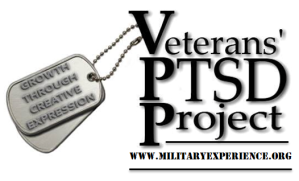The Veterans’ PTSD Project – Who We Are
The Veterans’ PTSD Project is led by a group of veterans and veterans’ supporters dedicated to changing the national conversation about PTSD. Through online outreach, artwork, and publications, this Military Experience and the Arts initiative is focused on sharing stories of hope, resiliency, and post-traumatic growth.
Why is this important? Too often, we hear stories about veterans who don’t survive the invisible wounds of war. Did you know that most veterans, including those battling PTSD, return home from war to lead productive lives? You wouldn’t from watching the national news media. Americans stereotype veterans as basket cases and ticking time bombs. But there is nuance.
We want non-veterans to know that, at least, they can try to understand. They can try to listen. And in trying, we can begin the work of letting our veterans know that we accept them as they are, not as we want them to be, not as the media depicts them. And we want veterans to see stories of resiliency, to use them as models, and incorporate the lessons of those who came before them into their efforts to re-assimilate.
Veterans with PTSD are fathers, mothers, sons, and daughters who’ve sacrificed a great deal for their loved ones while in uniform. Some of them are our volunteers—men and women who’ve lent their talents to informing, educating, and inspiring hope.
So, when you see the Veterans’ PTSD Project Logo, know that that’s us, doing our best to change the national conversation about PTSD.
The Veterans’ PTSD Project – History
The Veterans’ PTSD Project was founded by Virginia Cruse, who was diagnosed with Post-Traumatic Stress Disorder after her third time to Iraq in 2006. Virginia turned to her family and her “battle-buddies” with whom she had deployed. They found that they shared a common story, and, moreover, that they wanted to move on – from PTSD to resilience. In late 2008, Virginia, her cousin, Joan, and a close network of friends and family talked about their incredible journeys to Post-Traumatic Growth. They dreamed of a resource that would encourage other Veterans and Service Members by sharing success stories with others. Virginia and Joan launched The Veterans’ PTSD Project on September 11th, 2011 and dedicated their time to changing the national conversation on Post-Traumatic Stress to one of resilience, hope, and even Post-Traumatic growth.
In 2013, Virginia stepped down from the helm of PTSD project to pursue her career in counseling, handing it over Military Experience and the Arts. The Veterans’ PTSD Project became a part of a larger writing community and published its first volume of stories about post-traumatic growth not long after. Each author in the volume was provided with a free workshop, one on one consultations with expert authors, and their works were published alongside other MEA volumes. Today, The Veterans’ PTSD Project remains a powerful tool for veterans and their loved ones. By sharing stories of resiliency, hope-inspiring graphics, resources, news, and events, our team is on the forefront of the battle against stereotypes, misinformation, and prejudice. And we’ll keep fighting, not only until they all come home, but until they’ve all come home and been accepted back into society.
Blue Nostalgia is the signature publication of the Veterans’ PTSD project. Blue Nostalgia gives us a medium to connect to our brothers and sisters, while allowing the civilian community a glimpse into our world. There are many of us who have experienced the trauma that comes with armed conflict, but there are many more who have not, and never will. We veterans hold in our minds and bodies the history of our wars, and if the non-veteran community is to grasp who we are, what we have experienced, and what we are capable of as productive citizens, we must tell our stories.
In addition to experiencing war trauma, some of us have experienced military sexual trauma or trauma outside of a deployment. The stories of such trauma and the growth that follows need to be told.
The media traffics in tragedy and often fails to report on instances of post-traumatic growth, a concept few are familiar with, and that is the aim of Blue Nostalgia; to tell the untold, the unreported. Writing about trauma and the growth that follows is not easy. We understand that. Know this: You are not alone! Anyone who writes about such experiences goes through this unsettling and sometimes scary process of reliving trauma. If you are up to the task, please join us here at VPP to help change the national conversation about PTSD. After all, if we don’t tell our stories, who will? Learn more about how to tell your story here.
The Veterans’ PTSD Project – Our Team
If you see any of the people below on Facebook, Twitter, in an email, or as the author or artist of a work about post-traumatic growth, say hello. They work every day to help their fellow veterans and are dedicated to the mission of changing the national conversation about PTSD.
![]()

Joseph Stanfill served 14 years in the active army as a combat engineer, and is a veteran of OIF, OEF, & Kosovo. Joseph has dedicated himself to helping fellow veterans work their way through the myriad mental health issues surrounding combat, sexual assault, and transitioning. His passion is helping veterans to rediscover themselves following trauma, and recognizing the growth and strength obtained through their journey. Joseph’s research interests include psychotherapy, substance abuse, and the military family. He holds a Masters in Social Work from the University of Southern California, with a concentration in mental health and military social work. He is currently a psychotherapist working in the Department of Veteran’s Affairs. Joseph is married and blessed with two children. His hobbies include hunting, sports, and napping.![]()


I CAN’T GET TO THE ART GALLERY TAB, IT CLOSES BEFORE I CAN SCROLL DOWN TO IT.